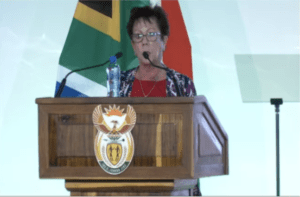 Good afternoon, Your Excellency President Ramaphosa, Ministers, dignitaries and industry partners, all protocols observed.
Good afternoon, Your Excellency President Ramaphosa, Ministers, dignitaries and industry partners, all protocols observed.
I am with Sassda, the Southern Africa Stainless Steel Development Association, and my focus will be on women and how to grow their role in the stainless steel sector.
Sassda has been recognised as the official voice of the stainless steel industry since 1964 and our focus is increasing the consumption of stainless steel that is locally converted in South Africa, and thus growing decent job opportunities and, through this create a competitive industry that can facilitate exports.
In terms of our Association, we have made steady progress towards empowering women and at this stage in our history we can claim that:
- 75% of the permanent employees of the association are women and
- 100% of consultants to the Association are female-owned.
In terms of our membership of around 200 members, we can boast that:
- 25% of our members have 40% or more female ownership.
We are also very proud of the level of professional women in our industry, whether business owners, financial or technical experts.
We recently conducted a series of discussions with female-led member companies in our association and I thought I would share a couple of their insights to give you a real ‘on the ground feel’ for how they view their role.
One of our members commented that traditionally, the manufacturing and steel industry has been dominated by men and that from a young age, boys were encouraged into these industries, by society, culture, parents and the education system.
It is a classic case of gender stereotyping, that women were not suited or have the aptitude for this industry with its many facets.
She felt strongly that this is not true, and it is important that through transformation, to instil a sense of confidence in women, that no industry is off-limits.
There is a need to create an environment that is diverse and inclusive, not based on gender, but based on capabilities, skills and potential, value systems and having the right attitude and work ethics.
By having more female leaders, it will encourage young women to enter into the industry.
Another female-led member feels that currently, there are not enough women players in the industry and despite the fact that women are an available and abundant resource that could be a pool of talent to be utilised.
However…the stark reality is that women are mostly found in traditional roles such as administration, accounting etc. It is rare to find women in the manufacturing and distribution of stainless steel and other steel-related products.
Stainless steel is a technical environment and women should be encouraged at the tertiary level to study engineering-related studies to build industry knowledge and to enable them to compete.
Companies should also be inspired to offer artisan opportunities that include women to build real skills and give them the ability to gain access to technical jobs as well as entrepreneurial advantages in the sector.
There are many opportunities in the downstream industries. Women can get involved in the manufacturing of stainless steel products, women can become wholesalers and distributors of stainless steel etc.
However, to succeed they will need financial as well as non-financial assistance (such as access to markets) to become meaningful players.
The benefit of this is that women will bring diversity and a new way of thinking to any male dominated industry. Women also tend to be more empathetic to issues related to the environment, social and health and, going forward for any organisation to be sustainable, these cannot be ignored
To achieve this type of transformation over the last decade it has been an industry focus to work more proactively with government, and, as such, Sassda has been working very closely with dtic on the Steel Master Plan. The Master Plan includes the localisation of products and import substitution.
This is very exciting for the stainless steel industry but can only be achieved through empowering people in the local industry and developing downstream markets.
This is also important to the national goals set by government and Sassda believes that the strengthened synergy between industry and government can lead to the eradication of unemployment and poverty – or at least go a long way to solving some of our socio-economic challenges.
Our statistics show that stainless steel and the conversion of it through skilled workers can lead to a very positive contribution to job creation.
In terms of job creation and empowerment, for every ton of stainless steel converted locally, we can equate it to the creation of some 35-40 jobs per ton, and this is instrumental in the fight against poverty.
Looking ahead, the Women’s Economic Assembly collaboration will assist our sector to fast-track gender transformation by giving a regulatory backbone to our endeavours and tangible targets to aim the developmental process of women in our organisation and industry sector.
Women will remain a key focus of our strategy and in the roll-out of value in the industry. We will continue featuring successful women as role models to the youth in our publications.
We can today commit to the following:
- Continue the current levels of involvement of women in our industry and association with the aim of growing this number by 20%.
- Commit to free and specific training programmes for all women in our industry during 2022.
- Identify women in our membership who can be further empowered through training and mentorship
- Identify members who can assist in a female mentorship programme.
And, finally, let us never forget the words of Graca Machel

